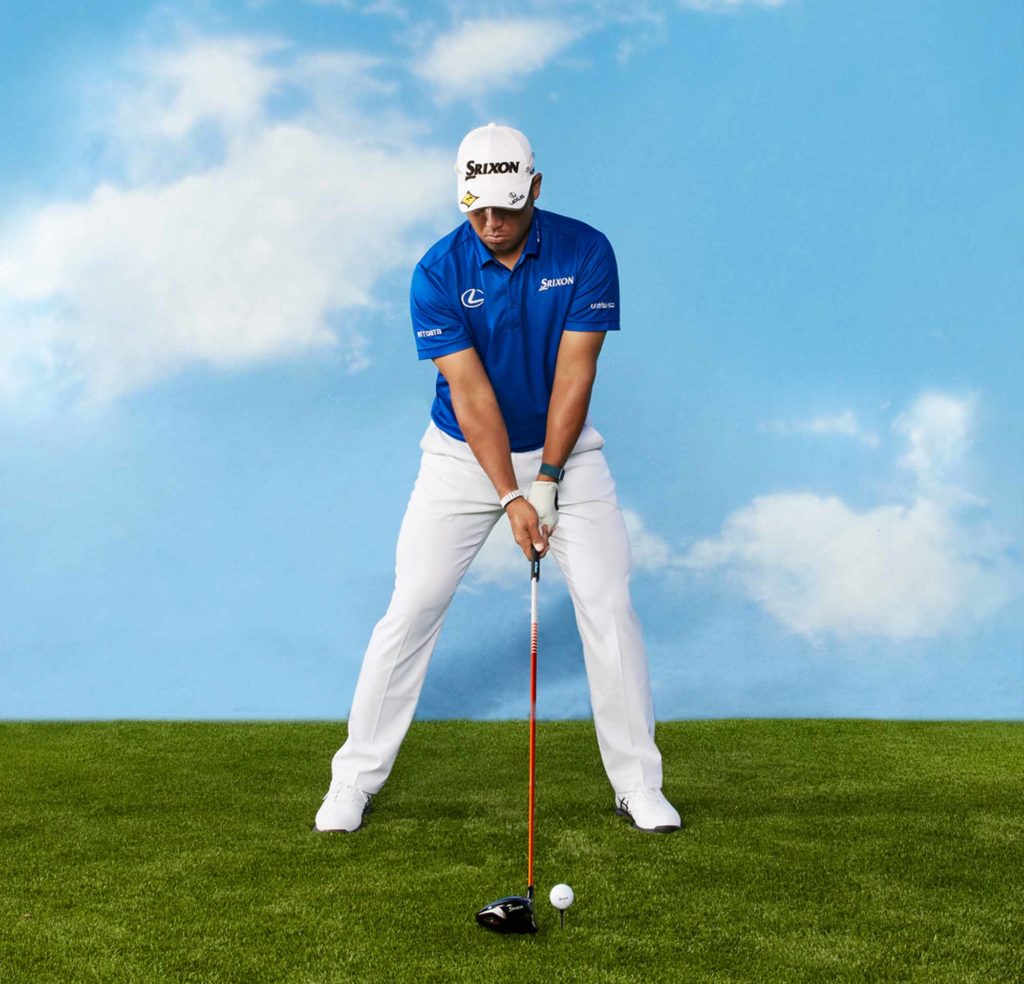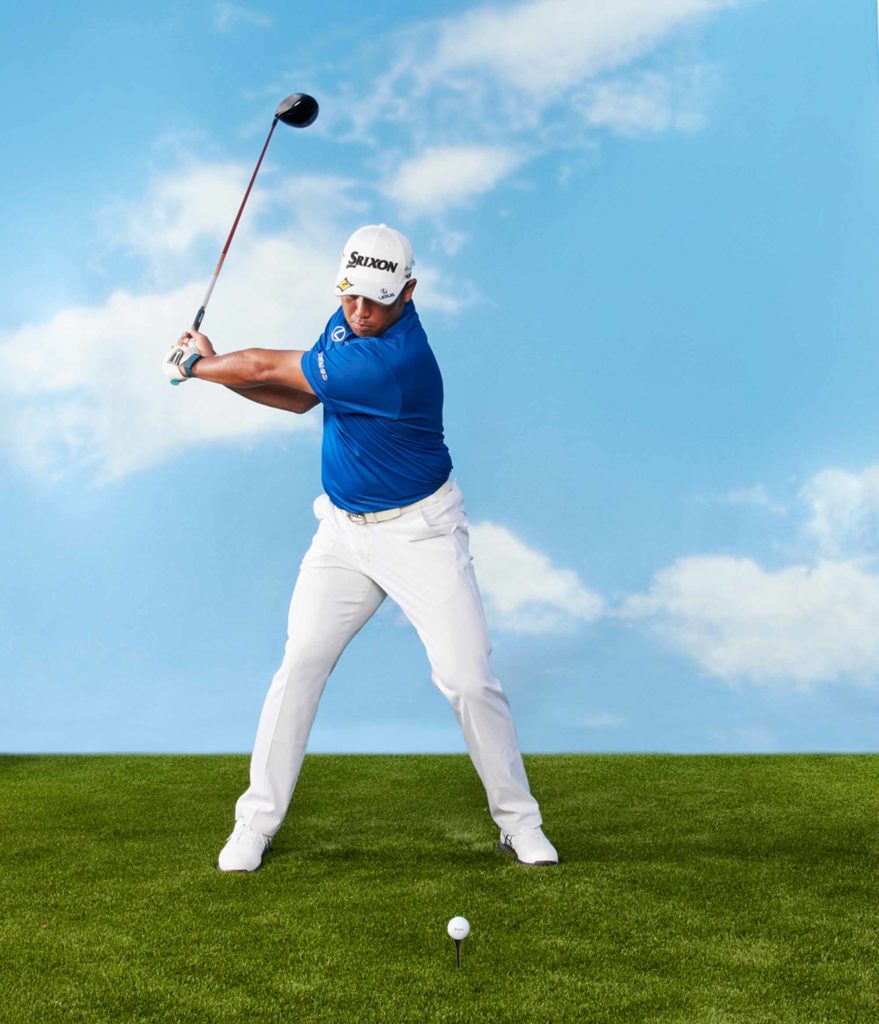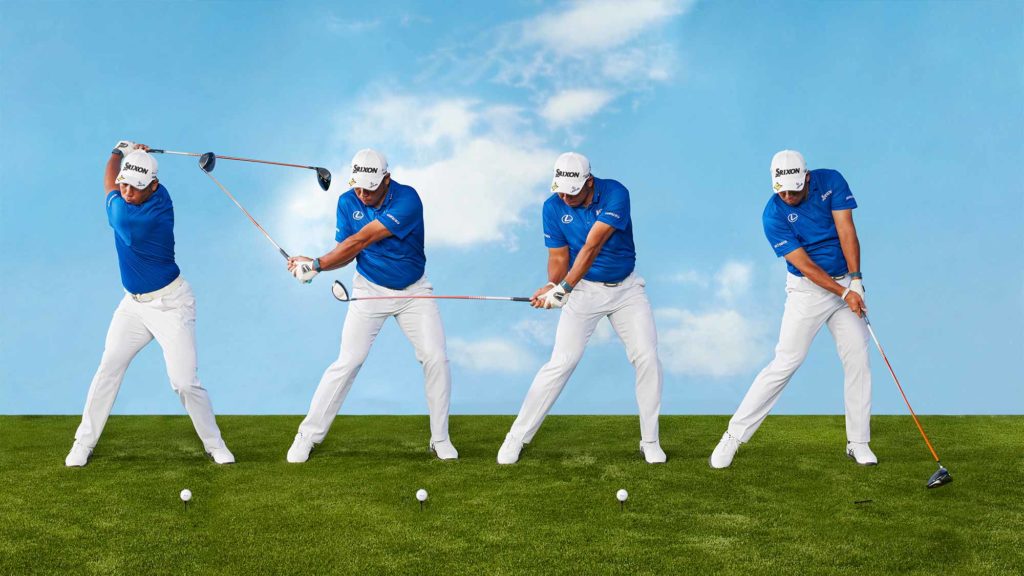Hint: It’s not his pause at the top
By David Leadbetter
Photographs by Yuri Hasegawa
With the Presidents Cup approaching, plenty of attention will turn to International team star Hideki Matsuyama and his distinctive swing. Broadcasters, podcasters, bloggers and such will undoubtedly point out the obvious – that he briefly stops at the completion of his backswing before starting down. How unusual is this move at the tour level? You have to go back to the 1950s to find another great player who did it – three-time Major champion Cary Middlecoff. Although Matsuyama’s pause isn’t as prolonged as it once was, it’s still the part of his game everyone highlights. However, a closer inspection of his swing reveals that there is something else going on, something that actually should be considered his signature action. It’s not as noticeable as the stop-and-go move, but it helps explain why Matsuyama is often regarded as an elite ball-striker. With the help of my good friend, sports biomechanist J.J. Rivet, I’m going to share with you our in-depth analysis of Matsuyama’s swing. If you stay with it until the end, you’ll find out how he’s able to hit 300-yard drives by creating energy very much like the ace on your favourite baseball team. I hope that piques your interest.
Let’s start logically at address – the very stable, structured setup you see him in here [below left] is worth noting. His wide stance with the driver reminds me of the Eiffel Tower, and it’s a precursor to the rock-solid, lower-body action that is a hallmark of his swing. This look of strength and stability also plays a key role in the elasticity of his body during the swing, which I will explain later.
Matsuyama has a great first move away from the ball, which amateurs would do well to copy. It’s the correct way to start – using the abdominal muscles to get the imaginary triangle formed by the arms and shoulders moving in one piece [below middle]. If you stood behind Matsuyama on his target line, you would see his clubhead path staying outside the path of his hands [below right] until the shaft gets parallel to the ground. This first move away, which is a common swing trait among tour pros, is something many amateurs don’t do. They instead jerk the club too far inside the target line. A good thought to get things started right is, Hands in, club out.



In reviewing a swing as good as Matsuyama’s, it’s hard to be overly critical, but one adjustment I would encourage is the way his right arm functions in the backswing. For many years, one golf-swing theory for better ball-striking is that the right elbow (for righties) should stay tucked to the rib cage for as long as possible. Players with great shoulder mobility, such as Ben Hogan and Vijay Singh, could easily keep that elbow pinched in all the way to the top. But for most players, that position is not attainable. Matsuyama keeps his right elbow pinched in until about halfway back, but then it “flares” as he approaches the top [below right]. If he let it flare far earlier in the backswing, where the right arm would appear on top of his left halfway back as opposed to being underneath it [below middle], the distance his arms travel would shorten – and that’s really important for efficiency.
Looking at the top of his swing [below left], notice how far his arms travel back. If he adjusted the position of the right elbow as it reached the top (ideally it would match his spine angle), it would restrict his arm swing. He would still be fully coiled, with a lot of power stored, but shortening the distance the arms travel would sync his swing better, eliminating some excess motion. His current arm swing is probably the subconscious reason he pauses at the top – he does it to re-sync his arms
and body.



If there was one thing Leadbetter would like to see Matsuyama adjust, it’s the length of his backswing. Matsuyama keeps his right elbow tucked to his rib cage until about halfway back, and then lets it flare as he reaches the top of his swing [right]. If he didn’t try to keep it tucked for so long, it would restrict the distance his arms travelled in the backswing. Currently, he gets the club past parallel [bottom, opposite page]. Ideally as he swung back, he would have his right arm above the left when it was level with the ground, unlike what you see here (top, opposite page). This would restrict his arm swing and make it more efficient. Any adjustment that makes a good swing easier to repeat is one all golfers should make, Leadbetter says.
Back to the positives in Matsuyama’s swing: remember earlier when I spoke of the look of stability in his lower body at address? Well, as J.J. Rivet and top golf-fitness trainers will tell you, the more stable you are, the more flexible you can be. You might not think at first glance that the 5-foot-11, 90-kilogram Matsuyama would be super mobile, but the camera doesn’t lie. The flex he maintains in his legs as he swings down into the ball is tremendous, and it helps him recover beautifully and get the club in a perfect position halfway down. I also love that after impact his left arm and shaft are in line, resulting in great extension in the follow-through.
If you’ve made it this far, I appreciate your patience in waiting to find out how Matsuyama’s swing is similar to a baseball pitcher’s mechanics. In J.J.’s analysis, he noticed that unlike many power players in golf, Matsuyama doesn’t really squat into the ground in the downswing to create more clubhead speed. Instead, he gets his energy from something J.J. calls “linear drift”. I’ll let him explain it.
“Look at his right leg and how it’s moving laterally towards the target [above],” Rivet says. “He’s drifting and rotating towards his target like pitchers do when they push off the mound. He keeps the flex in his right knee and has a tremendous amount of pressure out in the front of his right foot. That pressure is helping to generate rotational energy. He uses it to create a catapult-like relationship with his body and club, getting the driver to really pick up speed through the hitting area.”
Although other players, such as Dustin Johnson, also have a noticeable linear drift with the right leg, what makes Matsuyama’s move very unusual is that he doesn’t have to drop down to hit a big drive. He might not hit it quite as far as Johnson – Matsuyama averages 300 yards off the tee – but staying at roughly the same height makes it easier to control the strike, which leads to a more reliable driver swing. – with Ron Kaspriske

Hideki’s Drivers
Hideki Matsuyama’s past three wins on the PGA Tour have come with two different Srixon drivers.
The reason for switching is to match his driver’s performance to the course he’s playing, he says. In winning last year’s Masters Tournament, Matsuyama used Srixon’s ZX5 model, which promotes a higher ball flight with a draw bias – helpful at Augusta National, which has seven holes that favour a right-to-left tee shot.
At the 2021 Zozo Championship last October, Matsuyama had the ZX7 [left] in the bag. He also used it while winning this year’s Sony Open in Hawaii. The ZX7 has an eight-gram weight in the toe and a four-gram weight in the heel for a neutral flight. It also has a lower, more forward centre of gravity than the ZX5. This design promotes a more penetrating, lower-spinning trajectory that is easier to control.
Although it might not be practical to toggle between drivers, you could invest in an adjustable model and experiment with the settings to better match the courses you play. Whether it’s changing shot shape or trajectory, get the most out of your equipment – like Hideki.
– E. Michael Johnson

